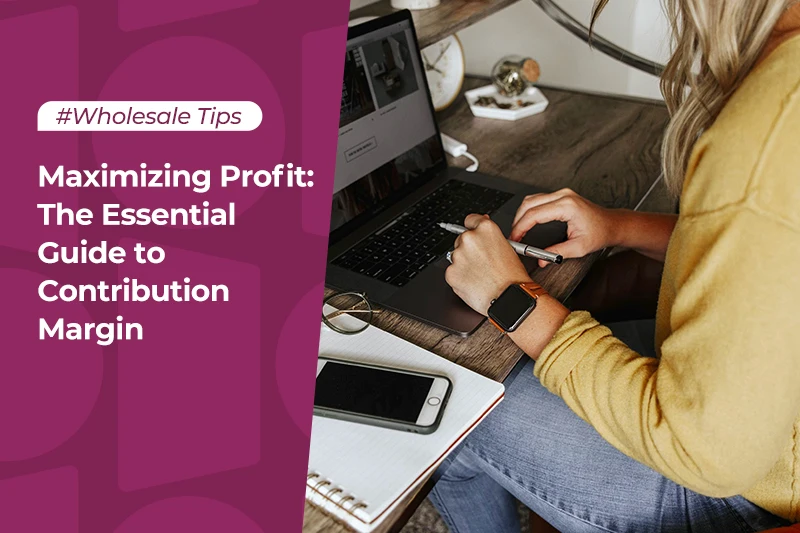9 wholesale trends you don't want to miss out in 2022

After the stop-start recovery in 2021, B2B wholesalers are likely targeting 2022 as a year of solid progress. The good news is that emerging facts and data about the new year look promising.
On the flip side, however, many of the headwinds that faced businesses last year are still unresolved. COVID is still a concern globally, and with inflationary conditions pushing up the prices of industry necessities, successful distributors will need to be agile and proactive.
To help as you set your plans and sales strategies for the year, we’ve rounded up the top wholesale trends for 2022.
We’ll start with a short primer on the industry's historical performance since the pandemic started and launch next into what to expect this year.
Table of Contents
How did the pandemic affect the wholesale industry?
COVID-19 will likely be remembered as THE event of this decade, if not the century. Such was the scale and severity of its global impact. There were visible and significant effects of the pandemic in practically every country worldwide and in most global industries.
The wholesale industry was particularly devastated by the viral pandemic. At the height of the pandemic, global trade ground practically to a halt. More than 90 countries imposed lockdown measures at one point, effectively forcing 3.9 billion people indoors.1
Major manufacturing and distribution centers such as China were some of the first and hardest hit. According to World Economic Forum (WEF) estimates, China accounted for 16% of global exports as of 2020. Likewise, the country held nearly 20% of intermediate product exports globally – signifying its vital role in the supply chains of companies worldwide.1
As a result, when the country went into lockdown, manufacturers couldn’t receive critical supplies, and production slowed or halted in several countries. The story was the same for other key manufacturing hubs like Japan, South Korea, Singapore, Thailand, etc.
Distribution woes also made wholesalers’ lives difficult at the height of the pandemic. Stricter public health protocols, labor shortages, and overloaded ports made shipping and transportation nearly impossible.
The Institute of Shipping Economics and Logistics says container throughput declined by 9.5% between January and May 2020.2 Likewise, the International Air Travel Association reported that air cargo tonne-kilometers declined 15.3% by April 2020.3
Therefore, wholesalers could not secure new stock to refresh inventory. And those who had inventory frequently could not move these on as retailers also faced their challenges. For instance, the food services sector lost over $120 billion in revenue from lost customers, spoiled inventory, lockdowns, etc.4
The impact of the pandemic was not all negative, though. While industries like manufacturing, hospitality, and tourism declined, others like healthcare and consumer tech boomed.
Pharmaceutical companies and manufacturers of personal protective equipment (PPE) were big winners. Logistics and last-mile delivery companies also performed well as they became the go-to for wholesale distributors and retailers.
E-commerce was also one of the bright spots during the pandemic. B2B and B2C sales soared as buyers and sellers flocked to online stores to place and monitor orders. For instance, B2B e-commerce purchases constituted 12% of the global total in 2020, and that share is set to rise to 17% by next year.5
Compared to the previous year, 2021 brought hope for business owners globally. And while that hope was not entirely fulfilled due to the enduring shockwaves of the pandemic, the year started a global economic recovery that will only pick up pace.
So, how can distribution companies and wholesalers ride this wave of positivity to success in 2022? Next up are the top trends to anticipate in the new year.
9 wholesale trends in 2022
There are indications that 2022 will be pivotal in the fight for a return to global economic normalcy. Here’s how things are expected to shape up in the wholesale industry.
1. Wholesale industry upturn
While 2021 gave wholesale distributors mixed outcomes, the market is expected to grow in 2022. Research indicates that wholesale market value will rise to over $64 trillion at a compound annual growth rate of 7%, up from $49.3 trillion.6
This points to increased trade volumes as business owners, and retailers look to meet global demand. The optimistic projections also underline the anomaly that COVID represents in terms of global economic growth. While the pandemic certainly created shocks, its effects do not represent any deep flaws in the global economy.
Considering the positive outlook, savvy wholesalers should begin to strategize accordingly. What are the best brands to sell? What products will your customers likely be interested in? Answer these questions early in the year so you can begin to make the right sourcing decisions.
2. E-commerce will lead

Digital sales through online stores provided crucial pressure relief for wholesalers during the pandemic. Reports suggest that this trend is set to continue as more B2B buyers take their procurement needs online.
For instance, according to Gartner, up to 80% of B2B sales will occur over digital channels by 2025.7 Similarly, Digital Commerce 360 reports in its B2B Buyer Survey that 40% of B2B buyers now fulfill at least 50% of their sourcing needs from online marketplaces.8
The statistics all point to one conclusion: having a wholesale e-commerce sales strategy might be the secret to success in 2022.
Recent years have already established e-commerce as a winning bet for early adopters. Those who work quickly to prioritize e-commerce can muscle into this space and secure digital real estate ahead of the online sales explosion.
One way to do this is to work on a proprietary digital sales channel. Incorporate an online store into your business website where B2B customers can start and conclude a purchase. Or you could explore the possibilities of a B2B marketplace such as Alibaba.com.
Comparably, a B2B marketplace potentially gives you all the benefits of your digital storefront without capital commitments. For instance, Alibaba.com supports you with brand exposure, order fulfillment, transaction protection, and the tools you need to take your business global.
Learn more here about why Alibaba.com is the B2B marketplace of choice for millions of buyers and sellers globally.
3. Reorganization of supply and distribution chains
Companies are reorganizing their sourcing and distribution network in response to the supply chain woes of recent years. According to the McKinsey Global Institute, between 15% and 25% of global trade will shift in the next five years as companies seek safer suppliers and distributors.9
Before the pandemic, the primary consideration was expertise and cost. However, as COVID cut companies off from critical suppliers and distributors, the focus has now turned to geographical accessibility and disaster-preparedness.
With the lessons learned in the past two years, companies are looking for distributors who can provide smarter and safer fulfillment options. The implication is that there’s likely a new role waiting for your distribution company if you have the required processes and experience.
There are many ways to position your firm in line with these opportunities. But low-hanging fruits will include showcasing a dependable distribution chain backed by industry best practises. In the long run, it’s also a good idea to implement automation across your entire process.
4. Growth in D2C channels
While some companies respond to the supply chain crisis by assessing safer distributors, others explore a direct approach. As a result, more companies are building out direct-to-consumer (D2C) sales channels, effectively cutting wholesalers out of their supply chain.
For instance, D2C sales in the US grew by 45.5% in 2020 alone.10 And more recently, huge brands like Nike and PepsiCo, which have traditionally used distributors, jumped on the D2C bandwagon.
The change was partly influenced by COVID, which forced brands to explore social media selling and digital D2C platforms to face the crisis. However, newer trends like corporate NFTs are pushing this trend further and leading to a growth in direct consumer sales.
The big question is: how do wholesalers respond to this trend? One way to respond is to show why you are better. If your service is fast, cost-effective, and precisely what your B2B customers need, show this story to the manufacturer.
Another option is to stand out to customers through value-added services. That means upgrading your service quality, using technology to become more efficient, etc.
5. Search visibility
With the transition of B2B wholesale distributors to digital selling, there’s an increased focus on search visibility. As sellers are finding, being online is one thing while being visible to your target market is an entirely different proposition.
To help reach more buyers, wholesalers are investing in search engine marketing. According to recent data, 40% of wholesale e-commerce sellers say that they plan to build their search capabilities.11
The search engine tactics of interest include paid ads and, particularly, search engine optimization (SEO). Sellers look to SEO for its ability to create brand awareness and authority, in addition to how it fosters search visibility.
Besides, SEO promises long-term results because it promotes good internet practices that search engines love. Therefore, wholesalers that intend to lay the foundation for success this year can benefit from investing in SEO for their website and e-commerce store.
Sellers who already have a digital storefront on a B2B marketplace or plan to open one may already be covered. Top marketplaces like Alibaba.com incorporate world-class SEO strategies into their store and website design.
6. Omnichannel selling
Another trend that will likely strengthen in 2022 is buyers' preference for omnichannel services. One of the effects of COVID was a growing preference amongst buyers for multiple purchasing channels.
Increasingly, customers want to be able to access your services on mobile, web, and physically whenever they like. As McKinsey reports, omnichannel is now a leading preference for consumers, and they demand this service from sellers.12
While the trend has been more prevalent in B2C transactions, these preferences are also finding their way into B2B sales.
Remember that B2B buyers are still individuals who interface with retail businesses on their own time. Therefore, they expect similar ease and personalization options as they enjoy during their personal shopping.
7. Labor shortages
Labor shortages were a constant for wholesalers in 2021 as workers grappled with the uncertainty of COVID-19. Those challenges and the underlying factors are still unresolved, meaning businesses might still face these shortages in 2022.
Where COVID was not a factor, questions over low pay, digital skills, and flexible work arrangements have led to a labor squeeze in countries like the United States and the UK.
Wholesalers will have to observe this trend and prepare adequately. If you do not have the staff to meet demand, then all your strategic plans for 2022 might be for nothing.
There are a few solutions you might explore in meeting this challenge. Consider offering more or better incentives such as productivity bonuses, daycare assistance, and paid time off. Also, better healthcare benefits, mental wellness plans, and a schedule that protects employee health can be valuable.
8. Smart inventory management

Because wholesalers typically operate at the bulk supply level, they frequently deal with outsized inventory problems. For instance, the inventory experience becomes more complicated when managing five to ten large-sized warehouses.
To make the experience smoother and easier on staff, wholesalers are adopting inventory management software to help. The software may be a standalone solution or part of a broader enterprise resource planning (ERP) platform.
The benefits of intelligent inventory management are numerous. With such a platform, it’s easier to monitor stock at a glance, determine what goods are selling and which ones aren’t, project demand, etc.
Incorporating intelligent ERP or inventory management software into your operations would be an excellent step for 2022.
9. Data analysis
The big data explosion arrived in the 2010s and has accelerated ever since. Concepts like the internet of things, the internet of everything, and the metaverse all build on big data. Essentially, they utilize the vast amounts of data that businesses create during their daily business.
Everything from how frequently a customer orders products to the type of products they prefer and changes in their routine constitutes data. With data analysis, wholesalers can make that data work for them.
You can explore your data troves to create sales forecasts, anticipate demand, or even re-evaluate your processes. Data can tell you what you’re doing wrong, what you’re doing well, and what steps can help you improve.
The great news is exploiting this data may not require a considerable capital outlay. If you use ERP software, the chances are high that much of that data is already available. Likewise, if you operate a digital storefront on a B2B marketplace, you likely have free business intelligence tools that can help.
The most important is knowing the data you possess and exploiting it to further your business goals.
Start your wholesale business on Alibaba.com
Overall, there’s no doubt that 2022 will bring immense opportunities for wholesalers. What is paramount is acting early to position your business in the best ways to take advantage.
As these trends show, success in the new year will go to sellers who plan and prepare adequately. And one way to do that is to put your business on the world stage by becoming a part of the world’s largest B2B marketplace.
Alibaba.com has the reach and pedigree to help your business access more buyers and greater revenue. Would you like to know more about the platform? Please read our guide on how to sell on Alibaba.com.
References:
1. https://www.pwc.com/ng/en/assets/pdf/impact-of-covid19-the-supply-chain-industry.pdf
2. https://www.isl.org/en/containerindex/may-2020
3. https://www.iata.org/en/iata-repository/publications/economic-reports/cargo-chartbook---q2-20202/
4. https://www.qsrmagazine.com/fast-food/restaurant-industry-has-already-lost-120-billion
5. https://www.dhl.com/discover/en-global/business/getting-to-market/make-the-most-of-b2b-marketplaces
6. https://www.researchandmarkets.com/reports/5240228/wholesale-global-market-report-2021-covid-19?utm_source=BW&utm_medium=PressRelease&utm_code=63lpds&utm_campaign=1503498+-+Global+Wholesale+Market+Report+(2021+to+2030)+-+COVID-19+Impact+and+Recovery&utm_exec=jamu273prd
7. https://www.gartner.com/en/newsroom/press-releases/2020-09-15-gartner-says-80--of-b2b-sales-interactions-between-su
8. https://www.digitalcommerce360.com/2021/07/06/diversity-is-key-in-growing-industry-marketplaces/
9. https://www.wto.org/english/res_e/booksp_e/wtr21_e/00_wtr21_e.pdf
10. https://www.emarketer.com/content/why-more-brands-should-leverage-d2c-model
11. https://www.the-future-of-commerce.com/2021/12/20/martech-trends/
12. https://www.mckinsey.com/business-functions/marketing-and-sales/our-insights/omnichannel-in-b2b-sales-the-new-normal-in-a-year-that-has-been-anything-but
Start your borderless business here
Tell us about your business and stay connected.
Keep up with the latest from Alibaba.com?
Subscribe to us, get free e-commerce tips, inspiration, and resources delivered directly to your inbox.














